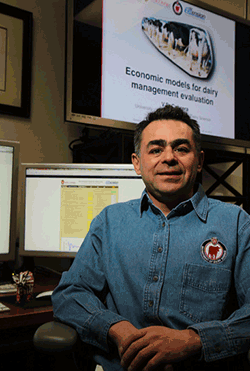
 Victor Cabrera isn't an expert in cattle genomics or reproduction. He hasn't spent a day in a lab running tests on the nutritional content of feed. In fact, Cabrera, associate professor in the University of Wisconsin-Madison dairy science department, spends most of his time in front of a screen building economic modeling programs.
Victor Cabrera isn't an expert in cattle genomics or reproduction. He hasn't spent a day in a lab running tests on the nutritional content of feed. In fact, Cabrera, associate professor in the University of Wisconsin-Madison dairy science department, spends most of his time in front of a screen building economic modeling programs.If you didn't know better, you might think he was in the wrong department. But Cabrera is right where he belongs. He shares one crucial thing in common with the rest of the department's faculty: He's working to help farmers get more from their dairies.
"I do a lot of my research on a computer, making simulations where I try to put a dollar value on reproductive programs, or nutrition protocols, or the adoption of new advancements and see if it makes [financial] sense or not," Cabrera explains.
The result is a suite of online programs that Cabrera offers for free on his Extension website (dairymgt.uwex.edu). These "decision support tools" evaluate the costs and potential benefits of just about any change a farmer might be considering. The site offers more than 50 such tools, with titles like "Grouping Strategies for Feeding Lactating Dairy Cattle," or "Exploring Timing of Pregnancy Impact on Income Over Feed Cost."
Those titles might bewilder those outside of dairy circles, but for farmers, the decision tools are roadmaps to best dairy practices.
"When we recruited Victor, we really wanted someone who could work with virtually everyone in the department to bring a science-based economic structure into the dairy farm decision process," says Pamela Ruegg, dairy science professor and Extension milk quality specialist. And, she says, that's exactly what he's done, putting UW-Madison research into the day-to-day operations of a dairy.
That's not to say it's been easy. Changing the way things get done on a farm is a major undertaking, Cabrera says. Farmers are loath to tweak something they've been doing for decades if they're not confident that it will improve profits and efficiency.
"Situations on the farm change constantly, and that means the right' decisions aren't always the same," Cabrera says. "My programs allow farmers to define their own conditions with their own data, making sure the resulting decision will fit their specific system."
The idea of dairy farmers as computer modelers may seem like a stretch to some. But, in fact, it's like all the other new technologies-like GPS-guided precision nutrient application or robotic milkers-that they're adopting to cope with economic uncertainty and thin profit margins. And even if a farmer isn't interested in Cabrera's online tools, it's likely that someone else-an extension agent, consultant, nutritionist or veterinarian-will use them to plan for that farm's future.
In 2013, Cabrera's simulations and models helped 1,300 different users each month, and that number is growing. That's great for the dairy science department as well as the farmer, says department chair Kent Weigel, because it helps funnel new knowledge directly from the lab to the farm.
"If my research leads to a discovery in the area of dairy cattle genomics, I can publish the results in journal or show them at a scientific meeting and hope that someone takes the next steps," Weigel says. "But if I collaborate with Victor, there is a pretty good chance my work will get used effectively and help improve the profitability of dairy farms."
Since arriving in Madison six years ago as an assistant professor, Cabrera's efforts to connect research with extension outreach have exceeded the goals that had been set for his position. Now, newly promoted to tenure status, he wants to help usher in the next big phase of online tools.
"Whether they completely embrace computers or not, farmers are using more data analysis and software on their farms," Cabrera says. Most farm equipment comes with software installed these days, but none of the information that software generates is "centralized" to provide the big picture of the farm as a whole. "That should be something that changes," he says. "It will all have to somehow be connected and, hopefully, my lab will help with that connection."
2.14.2014